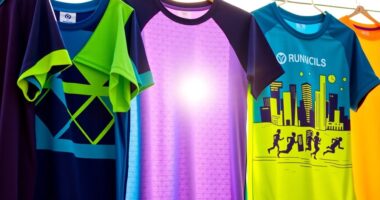To choose the perfect running shoes for your foot type, start by identifying your pronation type: neutral, overpronation, or supination. Conduct a wet test or consult a specialist for gait analysis to better understand your needs. Next, select shoes specific to your arch support—motion control for low arches, cushioning for high arches, or stability for moderate cases. Don't forget to check heel drop and guarantee a proper fit. Discover more tips to enhance your shoe selection process.
Key Takeaways
- Identify your foot type and pronation using methods like the wet test and gait analysis for optimal shoe selection.
- Choose motion control shoes for low arches and overpronation, while high arches benefit from neutral or cushioning shoes.
- Consider cushioning preferences: plush for long distances, moderate for balance, and minimal for ground connection.
- Pay attention to heel drop; traditional shoes suit heel strikers, while zero-drop models promote a natural running style.
- Ensure proper sizing by measuring both feet, trying shoes later in the day, and leaving space in the toe box for comfort.
Understanding Pronation Types

When you start running, understanding your pronation type is essential for choosing the right shoes.
Pronation refers to how your foot rolls upon impact, and recognizing your type can prevent injuries and enhance performance. There are three main types: neutral, overpronation, and supination.
If you experience neutral pronation, you'll benefit from neutral running shoes, which provide balanced support. However, if you have overpronation, your foot rolls excessively inward, increasing injury risk. In this case, look for shoes designed for overpronation, offering extra stability and cushioning.
To identify your pronation type, examine wear patterns on your current shoes or consider a gait analysis at a specialized store. This knowledge helps you make informed decisions for your running journey.
Analyzing Your Foot Type
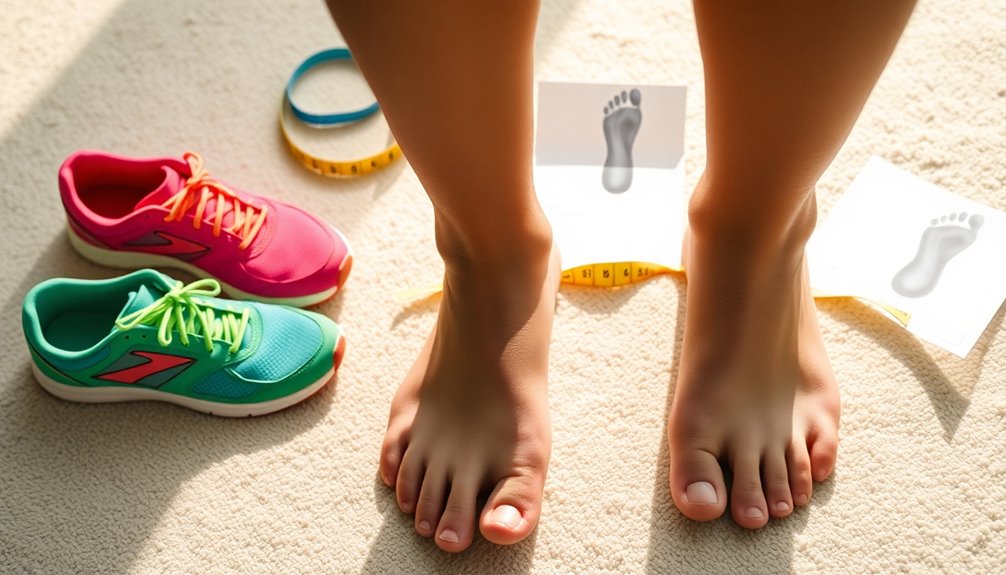
To find the right running shoes, you need to analyze your foot type.
Start with the wet test to identify your arch type and check your wear patterns to understand how your feet hit the ground.
This information is essential for ensuring comfort and preventing injuries while you run.
Identifying Arch Types
How can you determine your arch type to find the perfect running shoes? Start with a wet test: wet your feet and step onto a paper surface.
If you see a distinct curve, you have a normal arch. A nearly full imprint indicates a low arch, while a significant curve with minimal connection between heel and toe signifies a high arch.
Knowing your arch type is essential for selecting shoes. If you have low arches, consider motion control shoes to help with overpronation. High-arched individuals should opt for cushioning shoes to enhance comfort and support.
Wear Pattern Analysis
Understanding your arch type is just the beginning of finding the right running shoes. Analyzing wear patterns on your shoes can reveal your foot type and pronation, which are essential for selecting the right footwear.
If you notice an S-shaped wear pattern, you're likely a neutral pronator, indicating efficient foot mechanics. On the other hand, if wear is concentrated along the inside edge, you're probably overpronating, often linked to flat feet or low arches.
Supinators typically show wear on the outside edge, reflecting an outward roll and high arches, needing extra cushioning. Regularly inspecting these wear patterns helps you make informed decisions about future shoe purchases, enhancing comfort and preventing injuries.
Determining Your Gait
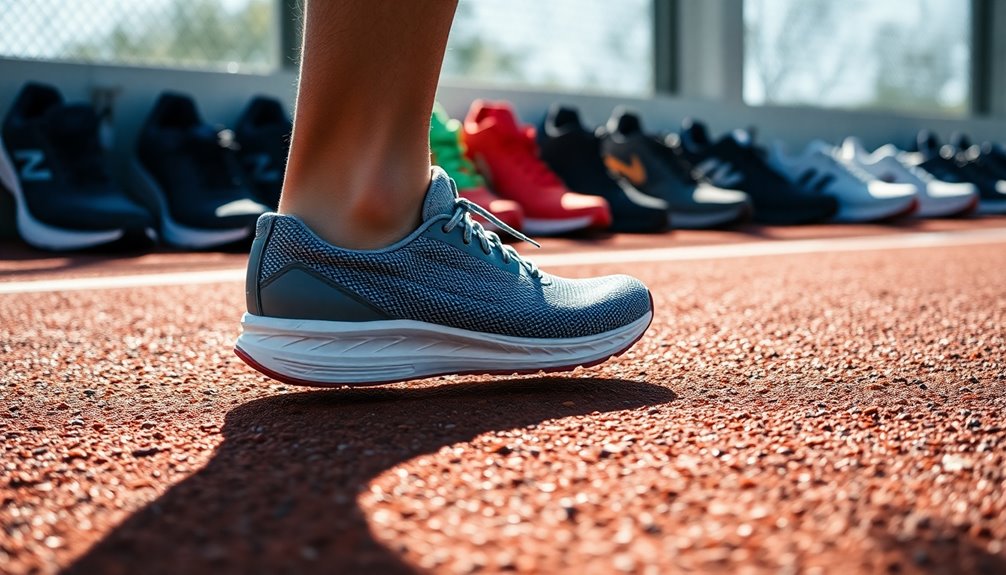
To find the right running shoes, you need to analyze your wear patterns and understand your gait.
A proper gait analysis can reveal whether you overpronate, underpronate, or have a neutral stride.
If you're unsure, consulting a specialist can help you make an informed choice that enhances your running experience.
Analyze Wear Patterns
Examining the wear patterns on your old running shoes can provide valuable insights into your gait and help you choose the right footwear.
By analyzing wear patterns, you can identify your pronation type, which is essential for selecting shoes that support your foot impact mechanics.
- Feel empowered to make informed choices
- Avoid injuries from improper footwear
- Enhance your running performance
- Enjoy a more comfortable experience
- Find shoes that truly fit your needs
Neutral pronators usually show an S-shaped wear pattern, while overpronators have wear along the inside edge.
Supinators will reveal wear on the outside edge. Understanding these patterns can guide you to the perfect pair of running shoes tailored specifically for you.
Gait Analysis Importance
When you assess your gait, you're revealing essential insights into how your feet interact with the ground, which is important for selecting the right running shoes.
A gait analysis helps determine your pronation type—whether you overpronate, have neutral pronation, or supinate. During this analysis, you'll likely run on a treadmill while a specialist observes and records your foot movement, identifying patterns that may lead to injuries.
By understanding your gait type, you can choose shoes that offer the necessary support and cushioning tailored to your running style. Additionally, gait analysis can uncover biomechanical issues, like overstriding, allowing for informed footwear recommendations.
Many running stores, like RunUnited, provide these valuable services for enhancing your running experience.
Consult a Specialist
How can you guarantee you're choosing the perfect running shoes? Consulting a specialist for a gait analysis is essential.
At a specialized store, you'll run on a treadmill while experts assess your foot motion. This process reveals your pronation type—whether you're neutral, overpronating, or supinating—ensuring you find the right fit.
- Discover the joy of pain-free runs
- Release your potential with proper support
- Avoid injuries that sideline your progress
- Experience comfort like never before
- Feel confident in every stride
With detailed insights from a specialist, you can select shoes tailored to your unique running style, minimizing injury risks and maximizing performance.
Don't overlook this vital step in your running journey!
Types of Running Shoes by Arch Support
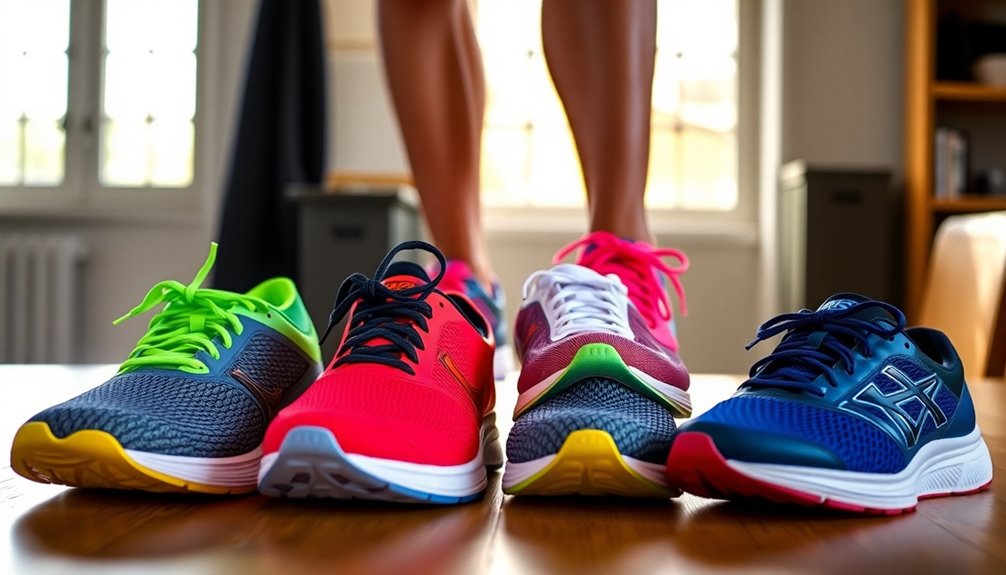
Choosing the right running shoes is essential for your comfort and performance, especially when considering the different types based on arch support. To ensure you select the best option for your feet, it’s important to understand your specific arch type—whether you have high, medium, or flat arches. A comprehensive Brooks running shoes overview highlights the various styles that cater to these needs, providing you with tailored support to enhance your running experience. Investing in the right pair can prevent injuries and improve your overall performance on the track or trail.
If you're a moderate to severe overpronator, motion control shoes offer maximum support with a rigid heel counter to prevent excessive inward rolling.
For mild to moderate overpronators, stability shoes provide a softer heel counter, allowing for flexibility while still delivering adequate arch support.
If you're a neutral runner, mild overpronator, or supinator, you'll benefit from neutral shoes, which have a flexible design without extra arch material.
Understanding these shoe types is vital, as proper selection based on arch support can prevent injuries and enhance your overall running experience.
Selecting the Right Cushioning

What level of cushioning do you prefer for your runs? The right cushioning can make a huge difference in your comfort and performance.
Here's a quick guide to help you decide:
- Plush, maximum cushioning for long-distance shock absorption
- Balanced, moderate cushioning for a mix of comfort and responsiveness
- Minimal cushioning to connect closely with the ground
- Barefoot shoes promoting natural foot movement
- Individual comfort preferences that shape your running experience
Ultimately, selecting the right cushioning boils down to personal preference.
Consider your running style and how you want to feel during those miles. Whether you crave softness or prefer a firmer touch, finding your ideal cushioning will enhance your running journey.
Choosing Between Road and Trail Shoes
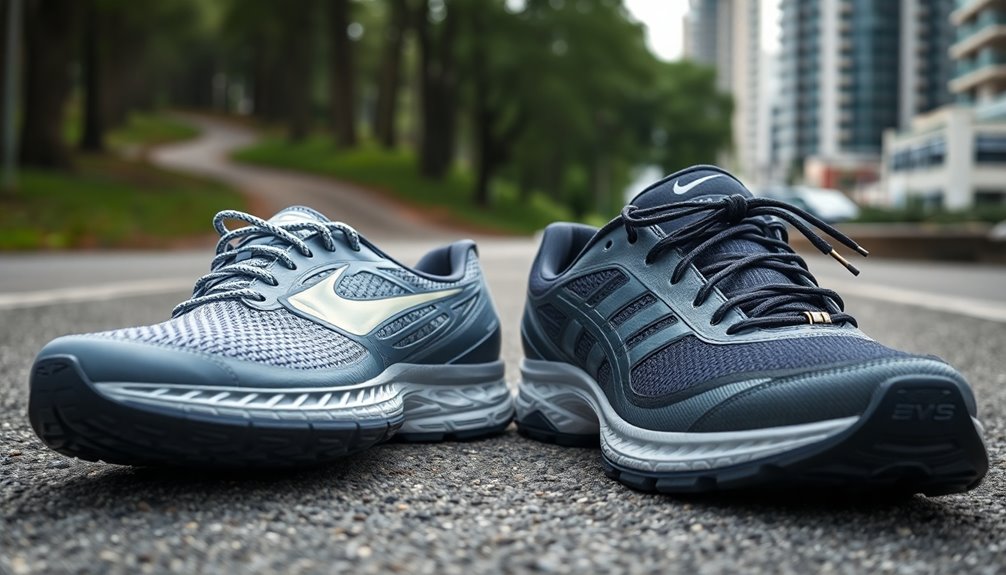
When it comes to selecting the right shoes for your runs, understanding the differences between road and trail options is essential.
Road shoes are lightweight and breathable, designed for hard, even surfaces like pavement. They focus on cushioning and arch support to absorb shock.
On the other hand, trail running shoes are stiffer, providing enhanced support for rugged terrains. They feature deep lugs and sticky treads for better grip, along with toe protection and rock plates to shield your feet.
If you run primarily on roads, opt for road shoes; for trails, choose trail running shoes.
While all-in-one models exist, specialized shoes tailored to your environment will maximize performance and help prevent injuries.
Importance of Heel Drop
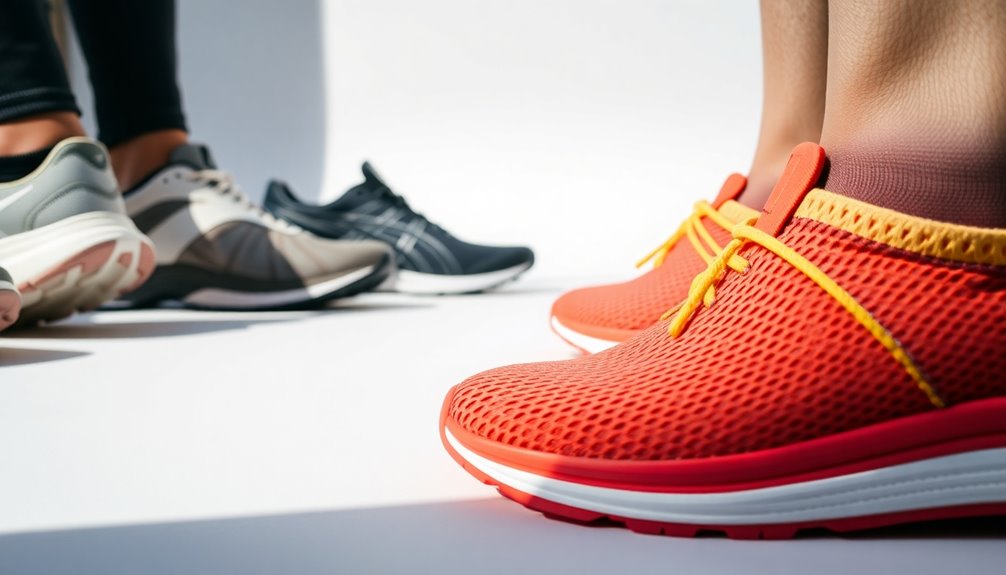
Understanding heel drop is vital for finding the perfect running shoes, as it directly impacts your running style and comfort. The heel drop, measured in millimeters, determines how your foot strikes the ground and can influence your risk of injuries.
- Feel the thrill of a pain-free run.
- Experience the joy of improved performance.
- Embrace the freedom of a natural stride.
- Avoid the frustration of recovery days.
- Discover the power of the right fit.
Choosing the right heel drop is significant. Traditional shoes with a 10mm drop offer shock absorption for heel strikers, while zero-drop models promote a natural strike.
Lower drops can enhance efficiency but may strain your Achilles. Tailor your choice to your running style for the best results!
Ensuring Proper Sizing and Fit
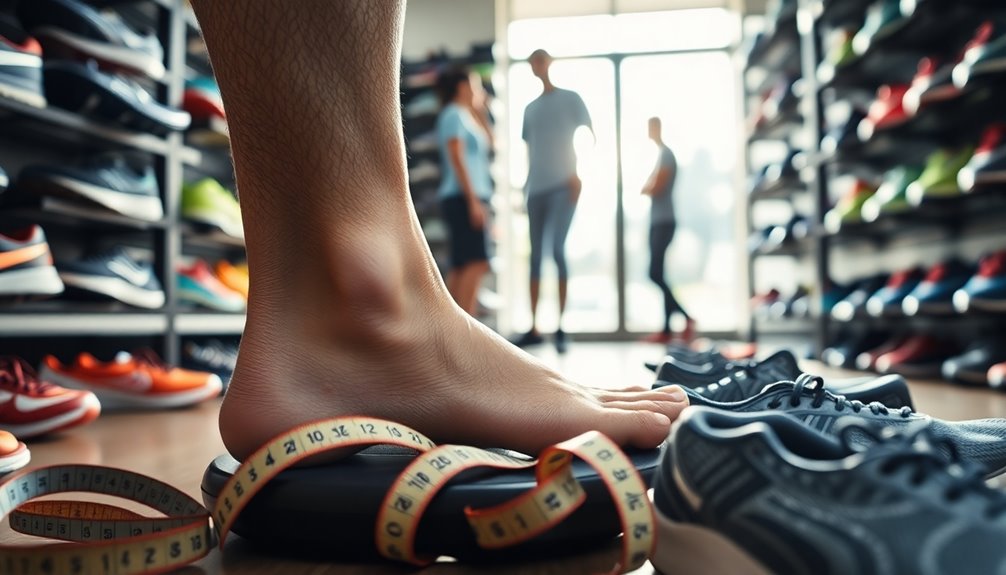
How can you guarantee that your running shoes fit perfectly? Start by measuring both feet for length and width, and choose the larger size to assure a comfortable fit.
It's best to try on shoes later in the day when your feet are slightly swollen, as this gives you a more accurate idea of sizing.
When you slip your feet into the shoes, aim for about a thumbnail's length of space in the toe box. This allows for natural movement and comfort while you run.
Don't forget to use your typical running socks, insoles, or orthotics during fitting.
Finally, ascertain the shoe feels comfortable right away—well-fitting shoes shouldn't require a breaking-in period.
Shopping for Your Ideal Running Shoes
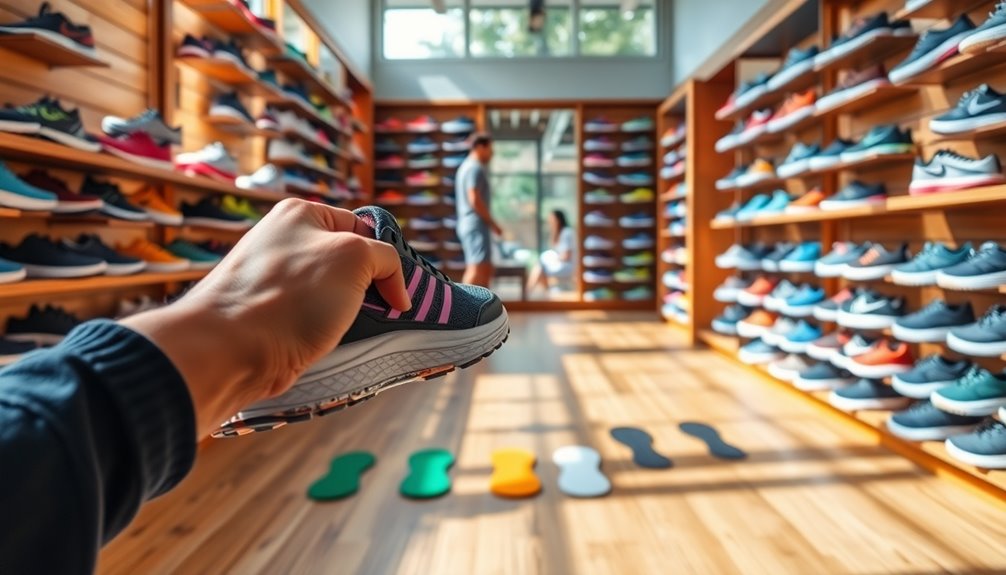
Finding the right running shoes goes beyond just getting the size right. You need to take into account your foot type and guarantee the fit is perfect for your comfort and performance.
Here are a few tips to help you shop effectively:
- Measure both feet; choose the larger size.
- Try on shoes at the end of the day for a realistic fit.
- Use proper lacing techniques to secure your foot.
- Test with your usual running socks or orthotics.
- Guarantee a thumbnail's length of space in the toe box.
Frequently Asked Questions
How to Determine Your Foot Type for Running Shoes?
To determine your foot type for running shoes, start with the wet test.
Wet your feet, step onto a paper towel, and check the imprint. If you see a distinct curve and less than half the width showing, you've got a normal arch. A flatter imprint suggests overpronation, while a high arch leaves minimal connection between heel and toe.
Also, check the wear pattern on your old shoes for additional clues about your foot type.
How Do I Know What Shoes Are Best for My Feet?
To find the best shoes for your feet, start by evaluating your pronation type and arch shape.
Conduct a wet test to determine your arch and check the wear pattern on your current shoes.
Consider your running surface, as different terrains require specific footwear.
Finally, don't hesitate to consult a specialist for a gait analysis; they can provide insights into your foot strike pattern, helping you make an informed choice.
Which Foot Type Is Best for Running?
Imagine your feet as the foundation of a house; the right type keeps everything stable.
When it comes to running, no single foot type reigns supreme. Neutral arches offer a balanced performance, low arches need supportive shoes to prevent overpronation, while high arches thrive on cushioning to absorb impact.
Understanding your foot type helps you find the best fit, enhancing your running experience and minimizing injury risks.
How Do You Tell if You Pronate or Supinate When Running?
To tell if you pronate or supinate when running, start by inspecting the wear patterns on your old shoes; if the inner edge is worn, you're likely overpronating, while wear on the outer edge indicates supination.
You can also do a wet test by stepping on a paper towel to check your arch type.
Finally, consider a gait analysis at a specialized store to observe how your foot rolls during your run.
Conclusion
Choosing the right running shoes is like finding the perfect partner for a dance; you need the right fit to avoid missteps. Just as every dancer has their unique rhythm, your foot type, gait, and preferences dictate the shoes that'll keep you moving smoothly. Remember, investing time in selecting the right shoes can prevent injury and enhance your performance. So lace up, hit the pavement, and let your feet lead the way to your best run yet!




